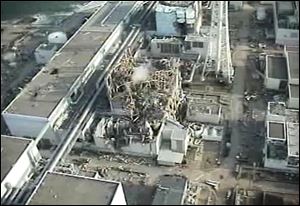
Japan widens evacuation zone, raises disaster rating to top level
4/12/2011
The crisis at the Fukushima Daiichi nuclear power plant stands at 7, the same as the Chernobyl accident in 1986.
TOKYO -- Japan is preparing to expand the evacuation zone around a crippled nuclear power plant to address concerns over long-term exposure to radiation, the government announced Monday.
Also, Japan's nuclear safety agency has raised the severity rating of the crisis at its nuclear plant to the highest level, on par with the 1986 Chernobyl disaster.
An official with the Nuclear Safety Commission of Japan, speaking on TV, said the rating was raised from 5 to 7.
The unnamed official said the amount of radiation leaking from the Fukushima Dai-ichi nuclear plant was about 10 percent of that in the Chernobyl accident.
Monday, thousands of people bowed their heads in silence at 2:46 p.m., marking exactly one month since a magnitude-9.0 earthquake and ensuing tsunami brought destruction to Japan's northeastern Pacific coast.
People across Japan at evacuation centers, at work, and on the street observed a moment of silence.
The overall death toll from the disaster has surpassed 13,000, with more than 14,000 people still missing, according to Japan's National Police Agency. The figures include the casualties from the March 11 quake and tsunami, plus the aftershocks that since have jolted the northeast.
Officials have said that many people may never be accounted for, because they were washed out to sea or buried under mountains of rubble. More than 150,000 people remain housed in emergency shelters, NHK said.
Another strong aftershock off Japan's Pacific coast briefly set off a tsunami warning amid the mourning.
The magnitude-6.3 quake killed at least one person and knocked out cooling at the crippled Fukushima Daiichi Nuclear Power Plant for almost an hour, underscoring the plant's reactors' vulnerability to seismic activity.
Workers at the stricken nuclear power complex found a small fire near a reactor building Tuesday, but it was extinguished quickly, the plant's operator said. It was unclear whether the fire was related to the aftershock.
Japanese authorities have ordered people within a 12-mile radius of the plant to evacuate, and recommended that people avoid the area within a wider radius of 18 miles. The new measures were in response to high readings of radiation in certain hot spots beyond those areas, underscoring the difficulty of predicting the ways radiation has spread from the plant.
Instead of spreading in even circles, the radiation has been directed to some areas and not others by weather patterns and the terrain. Iitate, one of the communities told Monday to prepare for evacuation, lies well beyond the 18-mile radius, but the winds have blown northwest from the Fukushima plant toward Iitate, which may explain why high readings were detected there.
Yukio Edano, the government's chief Cabinet secretary, said the government would order Iitate and four other towns and villages to prepare to evacuate.
The fear is that these areas are being exposed to radiation equivalent to at least 20 millisieverts a year, he said, which could be harmful to health over the long term. Evacuation orders will come within a month for Katsurao, Namie, Iitate, and parts of Minamisoma and Kawamata, he said.
People in five other areas may be told to evacuate if the crisis worsens at the Fukushima Daiichi station, he said.
''This measure is not an order for you to evacuate or take actions immediately," he said. "We arrived at this decision by taking into account the risks of remaining in the area in the long term," Mr. Edanio added, appealing for calm.
He said that the chance of a large-scale radiation leak from the Fukushima Daiichi plant had, in fact, decreased.
Mr. Edano also said that pregnant women, children, and hospital patients should stay out of the 18-mile radius, and that schools in that zone would stay closed.
The Japanese government before had refused to widen the zone, despite urging from the International Atomic Energy Agency. Countries such as the United States and Australia have advised their citizens to stay 50 miles away.
But Norio Kanno, Iitate's mayor, expressed dismay. "A full evacuation, a hollowing out of the village, is something I would have liked to avoid," he told public broadcaster, NHK.
Monday's aftershock came on the heels of Mr. Edano's announcement. The tsunami warning was lifted after 45 minutes. Still, the temblor touched off a landslide that killed a 16-year-old girl.
The quake also caused a spate of other injuries and left 220,000 homes in three prefectures without power, including those who have experienced blackouts after the quake last month, the public broadcaster, NHK said.
The blackouts' extent after the March 11 quake and its aftershocks highlight the vulnerability of Japan's power grid to seismic shocks. Monday's aftershock again knocked out the external power supply to the Fukushima Daiichi plant, temporarily stopping pumps there from sending cooling water into the facility's three most damaged reactors, Japan's nuclear regulator said. The tsunami warning forced plant workers to evacuate temporarily.
Using emergency pumps to cool the nuclear fuel rods within the reactors and in spent-fuel pools above the reactors has been a top priority for the operator of the plant, Tokyo Electric Power Co., since the March 11 quake and tsunami damaged the reactors' circulation systems. But Monday's aftershock seemed to have exposed a vulnerability to that approach.
The backup power and pumping systems that have been brought to the plant, including emergency diesel generators, fire trucks on standby, and other generator trucks -- all require workers to operate them manually, according to the Nuclear and Industrial Safety Agency. That makes them useless when workers must evacuate.
Hidehiko Nishiyama, deputy director-general of the Nuclear and Industrial Safety Agency, Japan's nuclear watchdog, acknowledged the problem but offered no solutions.
The Associated Press contributed to this report.